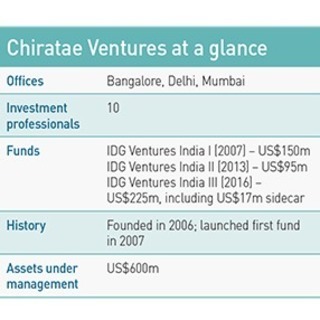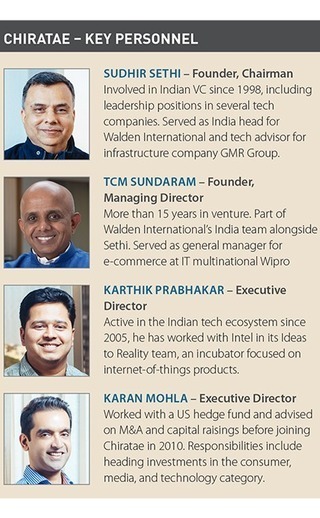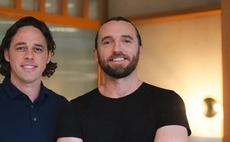
GP profile: Chiratae Ventures

Patient, culture-oriented Chiratae Ventures has grown and diversified in step with India’s gradually blossoming VC market. Its latest expansions suggest this trajectory is set to accelerate
When India's Curefit raised $75 million for its Series D round last month, it marked a turning point in the level of sophistication of local digital consumers as well as the start-up ecosystem they support. But this evolution is more clearly reflected by the story arch of the investors behind the deal.
Chiratae Ventures, which has backed Curefit since its first institutional round in 2016, holds the company up as an example of how India has changed and how the investment industry has had to change with it. Curefit, which operates a chain of brick-and-mortar gyms tied together with a suite of fitness apps, represents a deeper way of engaging Indian consumers, beyond the straightforward business remodeling associated with the country's first internet forays.
The VC firm started in the first decade of the 2000s with a pure online retail focus that befitted the buzz around India's initial digitization boom. Early successes under this strategy have revealed the changing landscape, however, and the need for nimble, opportunistic maneuvering. These investments include eyewear platform Lenskart, which has rapidly morphed into a complex offline-to-online model with an empire of 500 physical stores, and fashion retailer Myntra, which was bought by local e-commerce giant Flipkart, which itself was later acquired by Walmart for $16 billion.

"India today has more than 500 million internet users and many of them are mobile consumers, so it has evolved from a mere e-commerce strategy to content, commerce, and community. We're looking at a combination of consumer brands that are tech-enabled," explains Karthik Prabhakar, an executive director at Chiratae. "By our second fund, we became a combination of a bottom-up and top-down investor, still allocating to seed stage, but also in Series C onwards. That portfolio construct keeps a lookout for new trends and also creates early returns."
Changing its spots
Chiratae was founded in 2006 as IDG Ventures India by Sudhir Sethi, T.C.M. Sundaram, and Manik Arora, with the latter stepping down in 2015. Sethi, an engineer who worked for local tech heavyweights such as Wipro and served as India head for Walden International, played a key role in the initial set-up. After leaving Walden in 2002 and weathering two fizzled attempts to raise an independent fund, he struck a chord with Patrick McGovern, co-founder of International Data Group (IDG). A 30-minute meeting between the two men turned into a fateful 2.5-hour session.
Impressed by Walden exits like IT services company Mindtree, McGovern anchored a $150 million debut fund for the new firm in 2007, although Sethi's proposal had only contemplated $100 million. It was a familiar model for IDG, which had lent its name to similar ventures across Asia. McGovern was highly engaged, making some 30 visits to India during the firm's early years. A second fund closed at $95 million in 2013 and Fund III raised $225 million in 2016, including a $17 million sidecar.
After McGovern's death in 2014, IDG was acquired by IDG Capital – the China VC affiliate – and China Oceanwide Holdings Group. As part of the deal, they assumed ownership of LP interests in funds managed by other LP affiliates. These were then sold off to secondary investors. IDG Ventures India decided a rebrand was in order and chose Chiratae (meaning "leopard" in Bangalore language) as a way of inspiring a sense of group ownership. Several Chiratae team members, including Sethi and Prabhakar, are wildlife photography buffs, keen to translate the risk-taking, responsiveness, and agility that the hobby entails into an emerging venture industry.
"We realized that we had to reinvent ourselves, because India and the entrepreneurs were reinventing themselves. It became a strategic intention being communicated to the market," says Sethi. "The name came from our passion, and we're doing this because of a passion to build a new India, where the goal is to build Indian brands, which not only dominate at home but also in other parts of the world."
The firm set up its headquarters in Bangalore and within two years opened a second office in Mumbai, which was quickly shuttered when deal flow in the city proved unpromising. A Delhi office followed in 2013 and another small Mumbai base was established last year, this time strictly as an investor relations exercise. Deal flow continues to flow mostly from Bangalore and Delhi. A fourth office in Silicon Valley is planned for next year as a way of helping larger portfolio companies go global and tapping growing interest among US-based LPs.
Going local
Fundraising to date comes about two-thirds from international LPs and one-third from local investors, a ratio Chiratae aims to get closer to 50-50 in the years to come. The firm has about 20 global and 50 local relationships. About 40% of the Fund III corpus was sourced from India. "We are the only VC in the top-five in India that is raising Indian capital, so I think we believe in India much more," Sethi adds. "But it's not just from a money point of view. The returns will come – we're building this firm for the long term."
The increased focus on domestic capital represents another parallel with the macro picture as India experiences a new phenomenon of high-net-worth individuals launching family offices en masse and local corporates seeing the strategic benefits of plugging into the VC ecosystem. In an attempt to maximize its exposure to these trends, Chiratae has launched what it claims is the only formal co-investment program in Indian VC. This allows significant LPs to deploy a combined $83 million in de-risked, later-stage rounds. Uptake is said to be significant among domestic and foreign LPs alike.
"This is a very big strategic edge for us. Global investors give us the expertise, governance discipline and best practices while the domestic investors have knowledge about the nuances and challenges of building businesses on the ground here, which is invaluable," says Prabhakar. "Locally, it gives our portfolio companies an advantage when they move into tier-two and tier-three cities because most entrepreneurs are largely confined to the metro hubs. It's also a great confidence booster for global players who see it as a validation of the market opportunity."
Improved LP relations – whether through office expansions or the co-invest program – also play into a concerted exit-focused agenda. According to Sethi, all the economics at Chiratae have been overhauled in the past few years to become more exit driven. Moreover, quarterly reports require each partner to update their personal pipeline of divestment options. In weekly meetings, exits have replaced investment as the first order of business. The subject now takes up around 40% of weekly review time.
The goal to transact at least one exit a year has been realized for the past six years. In the past two years, more capital has been returned than has been deployed, with some $100 million transferred to LPs in 2018 alone. About 40 exits, including partial realizations, across 18 companies have been transacted to date. Sundaram says this outcome has required a change not only in strategy and procedural protocols, but also in culture.

Chiratae currently claims assets under management of $600 million, including 76 portfolio companies, at least nine of which are considered category leaders with market shares of 50-90%. Flipkart and Lenskart are among this batch, along with financial services portal PolicyBazaar and mother-and-baby retailer FirstCry. Helping these companies with international expansion is a growing priority that expresses yet another facet of the broader ecosystem's maturation.
"Founders do talk with other entrepreneurs in VC portfolios asking what the post-investment engagement model has been, whether the VC added value, how they did it, or how a specific partner interacted on the board to help," says Sundaram. "These questions are being asked by most new companies in the last 2-3 years about all VCs with whom they are engaging. That will be the biggest differentiator going forward."
Bench strength
The Chiratae roster currently consists of 18 professionals, including 10 investment team members and eight support staff. The investment team is headed by six partners: Sethi, Sundaram, and Prabhakar, as well as fellow executive directors Karan Mohla, Venkatesh Peddi, and Ranjith Menon. An additional seven new hires are expected within the next few months, including two professionals focused on seed investments. Additional sector-specific expertise in areas such as automotive and artificial intelligence is also on the radar.
An expanded bench is required to handle an expected bump in upcoming deal flow. The firm is in the initial stages of launching a fourth fund with a target of $275 million that will explore more deep tech categories in the vein of recent investments like interactive robot-maker Emotix. Decisions on large deals will continue to involve input from all team members, but recently employed measures have started to allow seed-stage plays to be greenlit by junior staff with only one partner signing off.
In-house skills development across investment, fundraising, value creation and exits has been a core philosophy from the beginning. Prabhakar, for example, joined Chiratae as a summer intern in 2010 with no fundraising experience. He is now heading the effort to raise Fund IV. "One of the biggest differentiators for us as a firm is that the founders totally believe in building the team from the ground up," he says. "It's very much about learning on the job and grooming within the firm, which is also the reason it's a very stable ship."
All six partners have worked together at Chiratae for at least eight years. The stability is attributed in part to the smallness of the team. It is unlikely that the firm will expand beyond 50 people within the next 10 years. Like the rebranding, the limiting of team size is expected to provide direction and cohesion to firm identity. To date, every recruit must spend 18 months at the Bangalore office before being deployed elsewhere as a means of ensuring assimilation.
"At the end of the day, if your culture is strong, your team will perform the best. What keeps a firm together is not money – it's value systems, culture and best practices. That's why people want to come to the office every day," Sethi says. "Skillsets can be taught, but attitude, fairness, governance, a strong competitive but open and transparent environment are things that are in your mindset. You don't want to mess around with culture. You can mess around with skillsets and go wrong, but this is the one thing that keeps you alive and kicking for a long time."
Latest News
Asian GPs slow implementation of ESG policies - survey
Asia-based private equity firms are assigning more dedicated resources to environment, social, and governance (ESG) programmes, but policy changes have slowed in the past 12 months, in part due to concerns raised internally and by LPs, according to a...
Singapore fintech start-up LXA gets $10m seed round
New Enterprise Associates (NEA) has led a USD 10m seed round for Singapore’s LXA, a financial technology start-up launched by a former Asia senior executive at The Blackstone Group.
India's InCred announces $60m round, claims unicorn status
Indian non-bank lender InCred Financial Services said it has received INR 5bn (USD 60m) at a valuation of at least USD 1bn from unnamed investors including “a global private equity fund.”
Insight leads $50m round for Australia's Roller
Insight Partners has led a USD 50m round for Australia’s Roller, a venue management software provider specializing in family fun parks.







